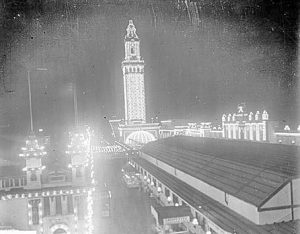Chicago the site of blimp disaster in 1919
By Paul Sassone For Chronicle Media — May 11, 2016
Owned by the Goodyear Tire and Rubber Co., the blimp was housed in an unused airplane hangar on the grounds of White City Amusement Park at 63rd Street and what is now Martin Lurther King Drive. (Photo courtesy of Library of Congress, American Memory, Chicago History Museum, Chicago Daily News negatives collection)
Blimps were a rare sight in 1919. And even though this was the blimp’s third flight of the day over the city, Chicagoans looked up entranced as the airship chugged through the sky over the Loop.
Enchantment would turn to horror when thousands saw the blimp burst into flame.
There had been no sign of trouble earlier in the day when the blimp began its first flight. Owned by the Goodyear Tire and Rubber Co., the blimp had been shipped to Chicago from Akron, Ohio, and housed in an unused airplane hangar on the grounds of White City Amusement Park at 63rd Street and what is now Martin Lurther King Drive.
Goodyear hoped to ultimately use the 186-foot-long ship for passenger service. The flights over Chicago were intended to spark publicity and public interest.
The blimp’s gondola on that sunny July 21 afternoon contained five people. Cruising at 1,200 feet, the blimp was directly over the Illinois Trust and Savings Bank, Jackson Boulevard and LaSalle Street. The 2 1/2 story building was an architectural gem, capped by a marble and stained glass skylight rotunda.
Since it was close to 5 p.m. the bank was closed, but 150 bank employees still were working.
A witness reported seeing a small burst of flame at the front of the blimp. The ship then buckled and plunged through the bank’s skylight.
The airship’s passengers parachuted. One man’s parachute burst into flames and he fell through the skylight to his death. Another man broke both legs. Two parachutists landed with minor injuries, as did the pilot.
Bank employees weren’t as fortunate.
The blimp’s fusilage, with two heavy rotary engines and two gasoline tanks smashed through the skylight and onto the bank’s floor.
The tanks exploded sending a wave of flaming gasoline through the bank. Panic ensued, people jumped from widows, ran from the building ablaze.
Altogether, 13 people died — 11 in the bank and two blimp passengers — with 26 injured.
Surprisingly, though the central part of the bank was destroyed, it opened for business the next day.
The bank ran a newspaper ad stating in part, “A balloon fell through the skylight injuring and killing several employees. The physical damage will be repaired so that the bank will be able to transact business today.”
What had caused the disaster?
There never has been a definite answer. One theory is that a static electric spark set off the blimp’s highly flammable hydrogen gas.
The state’s attorney, which launched an investigation, even arrested 17 Goodyear employees. But no one ever was charged with anything.
About all that resulted was a resolution adopted by the city council that regulated flying over the city.
Within a week, the blimp crash would be overshadowed by national notoriety when race race riots erupted in Chicago.
Read the current issue of the Cook County Chronicle
Free digital subscription to the Cook County Chronicle
— Chicago the site of blimp disaster in 1919 —







